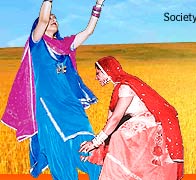Lohri Festival -13th Jan-2007

 Lohri Festival
Lohri FestivalLohri festival is an annual thanksgiving day and an extremely popular harvest festival in India, epscially Northern India. Come January, and the fields of Punjab are filled with the golden harvest of wheat and farmers celebrate Lohri during this rest period before the cutting and gathering of crops.
Time of Lohri According to the Hindu calendar, Lohri falls in mid-January (13th January). The earth, farthest from the sun at this point of time, starts its journey towards the sun, thus ending the coldest month of the year and announcing the start of the summer season.
Lohri Celebrations:-While Lohri is essentially a Punjab festival, it is celebrated in some other states of North India as well. In cities like Delhi, which have a predominant Punjabi population, Lohri is celebrated to denote the last of the coldest days of winter. Apart from Punjab, people from other northern Indian states of Haryana, Delhi and parts of Himachal Pradesh, become busy making preparations for Lohri. For them, Lohri is an appropriate occasion to come out of their homes and celebrate the harvesting of the Rabi (winter) crops and give in to relaxing and enjoying the traditional folk songs and dances.In houses that have recently seen pleasant happenings such as a marriage or childbirth, Lohri celebrations will reach a higher pitch of excitement. Punjabis usually have private Lohri celebrations, in their respective houses. Lohri rituals are performed, with the accompaniment of special Lohri songs. A bonfire is made and a prayer is performed to Agni, the god of Fire, and Prasad is distributed to all present. The prasad comprises of five main things - til, gazak, gur, moongphali (peanuts) and phuliya or popcorn. Milk and water are also poured around the bonfire. This ritual is performed for thanking the Sun God and seeking his continued protection.
Singing and dancing form an intrinsic part of the celebrations. People wear their brightest clothes and come to dance the bhangra and gidda to the beat of the dhol. Punjabi songs are sung, and everybody rejoices. Sarson ka saag and makki ki roti is usually served as the main course at a Lohri dinner. Lohri is a great occasion that does not hold importance for farmers alone but also to those people residing in the urban area, as this festival provide the opportunity to interact with family and friends. Thus, Lohri is a socially significant festival for one and all.
Lohri Celebrations in other Parts of India Lohri is celebrated throughout the country in different forms, as a harvest festival. It is called Pongal in the South, Bhugali Bihu in Assam, Bhogi in Andhra Pradesh and Sankranti in the central part of the country. Though modes of celebrating Lohri in India are different, but the message conveyed by the festival, that of setting aside differences and rejoicing by celebrating the end of the harvest season and the chilly winter is the same everywhere

